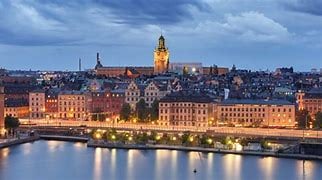
AsianOverland.net
Tour Guide - Itinerary
Asian Overland Sydney to London
Started 22/06/2022 Finished 21/06/2023365 Days ITINERARY
Day 233 date 09/02/2023OSLO, NORWAY to STOCKHOLM, SWEDEN
ASIANOVERLAND.NET RUSSIA SCANDINAVIA
DAY 9/233 1981 – OSLO, NORWAY TO STOCKHOLM, SWEDEN
Sweden is the largest country in Northern Europe, with Stockholm its capital and largest city.
Germanic peoples have inhabited Sweden since prehistoric times, emerging into history as the Geats and Swedes, and constituting the sea peoples and Vikings known as the Norsemen.
The Rus' people originated in what is currently coastal eastern Sweden around the eighth century. The name Rus' is derived from an Old Norse term for "the men who row" - rowing was the main method of navigating the rivers of Eastern Europe. The name Rus' has the same origin as the Finnish and Estonian names for Sweden: Ruotsi and Rootsi.
In the 750s, Scandinavian Vikings played a role in the formation of the Rus' Khaganate. The Vikings thereby started about a thousand years of Swedish dominance over Russia until Peter the Great built a fortress in a swamp which became known as St Petersburg.
The Varangians were Scandinavian/Swedish Vikings who migrated eastwards and southwards through what is now Russia, Belarus, and Ukraine mainly in the 9th and 10th centuries. Through invasion, plunder, trade, piracy, and mercenary activities, they reached the Caspian Sea and Constantinople.
The Varangians exacted tribute from the Slavic and Finnic tribes in 859. It was the time of rapid expansion of the Vikings in Northern Europe - England also began to pay Danegeld in 859.
In 862, the Finnic and Slavic tribes rebelled against the Varangian Rus, driving them back to Scandinavia, but then invited the Varangian Rus "to come and rule them" and bring peace to the region which became Russia.
In the 9th century, the Rus' operated the Volga trade route, which connected Northern Russia with the Middle East. As the Volga route declined, the trade route from the Varangians to the Greeks (Byzantine Empire) rapidly overtook it.
In the Viking years, Swedish men left to enlist in the Byzantine Varangian Guard in such numbers that a medieval Swedish law, Västgötalagen, declared no one could inherit while staying in "Greece"—the Scandinavian term for the Byzantine Empire—to stop the emigration.
In contrast to the intense Scandinavian influence in Normandy and the British Isles, Varangian culture did not survive to a great extent in the East. Instead, the Varangian ruling classes of the two powerful city-states of Novgorod and Kiev were thoroughly Slavicised by the begining of the 11th century.
An independent Swedish state emerged during the early 12th century.
After the Black Death in the middle of the 14th century killed about a third of the Scandinavian population, the Scandinavian Kalmar Union was formed in 1397. Sweden left the Kalmar Union in 1523.
When Sweden became involved in the Thirty Years War on the Protestant side, an expansion of its territories began and the Swedish Empire was formed - it became one of the great powers of Europe until the early 18th century.
Swedish territories outside the Scandinavian Peninsula were gradually lost during the 18th and 19th centuries, including the annexation of present-day Finland by Russia in 1809.
The last war in which Sweden was directly involved was in 1814 when Norway was militarily forced into a personal union, which peacefully dissolved in 1905. Since then, Sweden has been at peace, maintaining an official policy of neutrality in foreign affairs.
© This work is copyright. Apart from any use permitted under the Copyright Act 1968, no part may be reproduced by any process, nor may any other exclusive right be exercised, without the permission of Peter Searle, peter@portseavillageresort.com; 1980-2024.
Website built by Justin O’Dea www.webdeveloperdocklands.com.au




